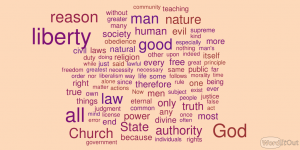[This is the second in a series: 1. The “Inner Other”; 2. Discovering the “Inner Other”; 3. Three ways to manage your “inner other”.]
In my last post, I spoke about the mystery of the “inner other” and the power it exercises over our interior life. And I asked, Where does this shadowy figure come from? We make him up ourselves, but how do we do it?
Usually the answer is fairly straightforward: the imaginary, interior interlocutor is a composite projection of our real, exterior interlocutors. He reflects the circle that makes up our lives, and he changes when we change from circle to circle. In fact, that is how I first became aware of him.
When I was young, my family and my friends were conservative and religious. This remained true when we transitioned from Protestantism to Catholicism, throughout my college years and all the way up to the completion of my masters degree. To the extent that I dealt more than superficially with people of a different persuasion, it was through reading.
When I began my doctoral program, however, I suddenly found myself in a completely new world: my professors and my fellow students were religiously liberal and sometimes not religious, they all focused on the same professional conferences and talked about the same books, and in general they had a coherent but entirely foreign set of priorities. What my social circle considered important and acceptable was suddenly different.
Part of this transition was helpful. I realized after a while that I had accepted certain arguments about Scripture not because they were strong arguments but because they had satisfied my interior interlocutor. When I imagined myself speaking argument X, in my imagination the results were great: Yes, of course, triumph! It was like making an argument against climate change in a room full of petroleum executives. So in certain respects my thought gained a new rigor from the transition to a new social group.
But not all the results were happy. In spite of my personal inclinations and background, I found that my own mental horizons swung slowly around to a closer match with that of the new group. I was aware of it at the time, and I could even feel the effects spike when I attended a conference: temporarily, the kinds of things likely to make for publication in such-and-such a journal seemed REALLY important while other things shrank. While I myself remained religiously conservative, my “inner other” was becoming a liberal biblical scholar.
I even noticed the effect when I tried to read the Bible devotionally. To read the Bible subjectively was anathema in the group, the worst thing one could do. But the objective meaning of Scripture was not what you might think: biblical scholar John Meier famously wrote that the objective meaning of a Scripture passage is what you would get if you locked a Catholic, a Jew, a Protestant, and an agnostic—all biblical scholars—in the basement of Harvard Divinity School and did not let them out until they reached a consensus. I felt that committee always judging me, even in my most private moments. The loose and comfortable feel of spiritual reading vanished.
During this period I also struggled with my Catholic faith. Because my own beliefs differed drastically from those of my “inner other,” my interior conversation turned into a never-ending debate: Oh yeah, prove this! Oh yeah, prove that! I felt that I was on trial every hour, and it was all the harder because the only evidence acceptable to this inner other was the kind of evidence that would have been acceptable to my professors and fellow students and all the people at the conferences. I found myself replaying and replaying and replaying arguments for the existence of God, parrying and thrusting, meeting objection after objection, running over the same ground again and again.
A number of things fell together for me around this time and saved me from mental exhaustion and possible loss of faith. My academic advisor was a true believer, a very important witness; I came to a new understanding of faith, as I have described in my blog series on faith; other things I will probably never write down. The relevant part for the present post is this: I realized that I had been trying to convince the “inner other” instead of trying to convince myself. When I honestly asked myself what persuaded me, Jeremy Holmes, I saw that the existence of God is actually easy to prove, stupidly obvious: the facts are apparent and the arguments clear. What is hard is not demonstrating the existence of God; what is hard is persuading an atheist. As soon I escaped the limitations my shadowy interlocutor imposed on the conversation, I found that I was not in anything like the trouble I had thought.
As I have gone on in life, I have observed the “inner other” phenomenon in myself time and time again. When I move to a new job and find new friends, suddenly I see the world against a new horizon; a new set of things seems to loom large and some things that seemed important before suddenly seem to shrink. When I withdrew from work this past year for my sabbatical, I found that I was able to reshape my horizon and realize that some things that seemed like big problems at work were neither big nor really my problem at all. When I am reading more of a particular set of authors, those authors shape my “inner other” for a while.
While my experience is pretty typical, not everyone reacts to a new social group the way that I do. I have met people who seem to be immune to transition because their “inner other” does not readily change, so that when they move on to a new social circle they retain the old interior conversation partner. The ongoing mismatch between their own priorities and those of their group create the impression that they are objective, above influence, free-thinking. But over time I have realized that their “inner other” is no less present, just more stubbornly persistent.
Similarly, I have known people of a less social disposition who form their “inner other” largely from books. They read constantly, and the “group” formed by the authors they read serves as a basis for the “inner other,” again creating the illusion that they are free of such influences because they don’t seem to measure their thought against the people actually around them.
In both cases, the impression of objectivity makes the situation more dangerous, because we tend to notice things when they move or change. When your “inner other” remains the same over time then you are less likely to notice “him” as something other than “you”.
So are we hopelessly and helplessly chained to the “inner other,” incapable of objective thought? By no means. In my next post, I’ll describe three approaches to making your “inner other” not an obstacle but an ally in the pursuit of truth.




